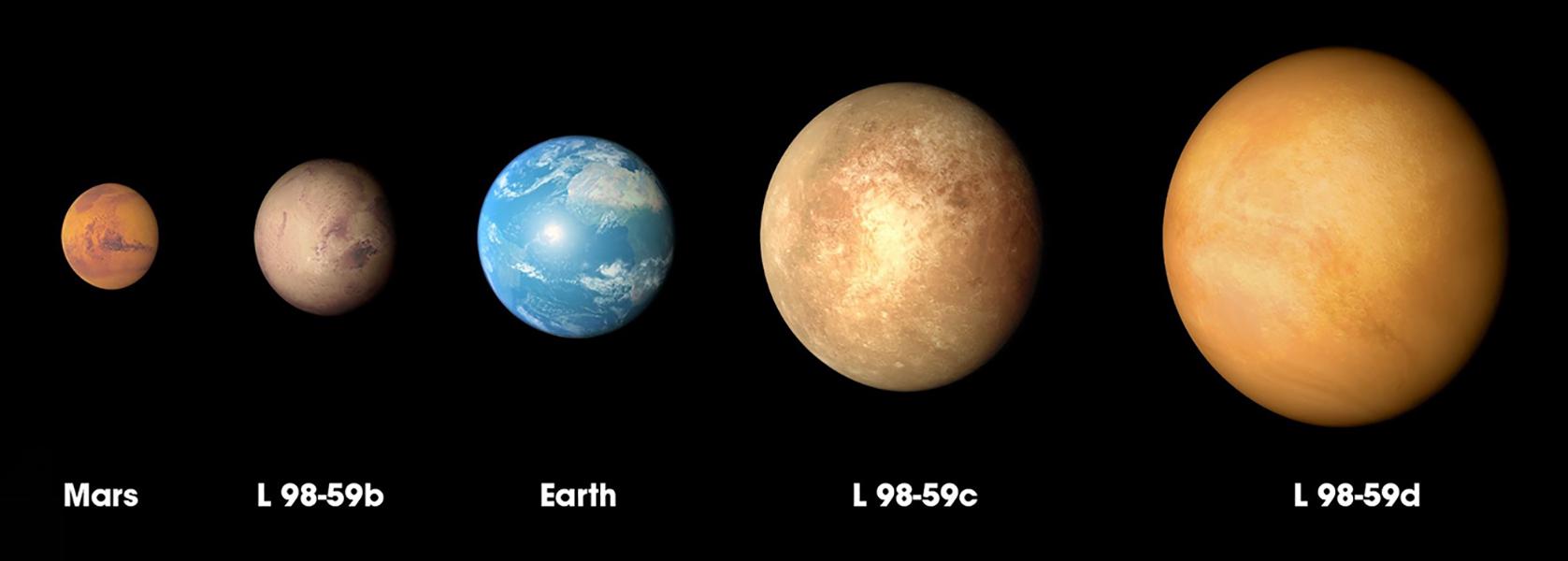
A planet slightly smaller than Earth and orbiting a nearby star has been detected by NASA’s Transiting Exoplanet Survey Satellite (TESS), a notable achievement for the space telescope. Forbes picked up the story with a comment from Veselin Kostov, a SETI Institute research scientist who was the lead author on a paper in the Astronomical Journal announcing the finding:
“The discovery is a great engineering and scientific accomplishment for TESS,” said Veselin Kostov, an astrophysicist at NASA’s Goddard Space Flight Center in Greenbelt, Maryland, and the SETI Institute in Mountain View, California.
“For atmospheric studies of small planets, you need short orbits around bright stars, but such planets are difficult to detect. This system has the potential for fascinating future studies.”
To date, this world – dubbed L 98-59b – is the tiniest exoplanet discovered by TESS. Two larger worlds in the system were also detected. While none of the planets are within their star’s habitable zone (the orbital range around a star in which planets could support liquid water and an atmosphere), over 1,800 stars have been cataloged for further study by TESS to look for planets that might be Earth-analogs.
- Forbes: TESS Mission Finds Small New World In Our Neighbourhood
- Universe Today: The Planet-Hunting TESS Discovers Its Smallest Exoplanet to Date
- SETI.org: TESS Mission Discovers Smallest Planet Yet
- The Astronomical Journal: The L 98-59 System: Three Transiting, Terrestrial-size Planets Orbiting a Nearby M Dwarf
 Survey Explores Public Opinion of First Contact
Survey Explores Public Opinion of First ContactIf we were to find proof of extraterrestrials, how would our species respond? That’s the question the UK SETI Research Network (UKSRN) hopes to answer with the largest-ever survey of public opinion on first contact. Inverse discussed the story and consulted Seth Shostak, Senior Astronomer at the SETI Institute, who brought up a 1996 false alarm as an example of how the public may react:
“To begin with, there are two kinds of discovery of life in space,” Dr. Seth Shostak, Senior Astronomer at the SETI Institute in Mountain View, California, tells Inverse. “One is the discovery of microbes, and we saw that in 1996 with the martian meteorite story. The public was interested and the media was modestly interested.”
Another scenario explored by the survey is one fans of the movie Contact, based on the novel by Carl Sagan, would surely be familiar with: detecting a radio signal from a technologically advanced alien species. Shostak elaborated on the likely response:
“So, what happens when you think you’ve picked up a signal is that you keep checking it and you ask other scientists to check it. It would take time to confirm and to decipher.”
“They might be in a completely different part of the world. So, now they all know about it, and then they might get somebody else to confirm it. Existing protocols say, to announce it to the world: check it, then tell everybody.”
Which brings up the subject of sending a deliberate message of our own – a somewhat controversial idea – which Shostak advocates against restricting to a short, carefully curated message:
“…if we were to broadcast something, instead of having a committee deciding what it should be, I would just send the Google servers’ — just send the entire internet, they’d be able to figure that out.”
“If you just send short messages like the Pioneer plaques, or the Voyager records, or all these short broadcasts that have been made to be a receivable message, that’s kind of a waste of time. You want to send lots of material.”
“We don’t know anything about alien sociology and the conclusions they’d make. I think that what they’d find is that, probably, the planet is ruled by cats.”
- Inverse.com: The Largest-Ever Survey of Public Sentiment About Aliens Begins This Week
- SETI.org: What Happens Next If We Find Proof of Space Aliens?
- Facebook Live: What Would We Do if We Found a Signal? (April 26, 2018)
 Unistellar Announces eVscope’s Exoplanet-Detection Abilities
Unistellar Announces eVscope’s Exoplanet-Detection AbilitiesA powerful, compact consumer digital telescope, Unistellar’s eVscope, not only allows stargazers to view comets, nebulae, and galaxies in exquisite, full-colored detail – it also has proved capable of detecting transiting exoplanets. The Unistellar team announced a single eVscope was able to detect two Jupiter-sized worlds by picking up the subtle dimming caused as they moved between their stars and Earth. SETI Institute Senior Planetary Astronomer Franck Marchis, who is also Unistellar’s Chief Scientific Officer, explained to ITedge News that a network of these telescopes could prove a formidable tool for science:
“Detecting transiting exoplanets with a worldwide array of these powerful backyard telescopes will generate invaluable astronomical data,” explained Franck Marchis, senior astronomer at the SETI Institute and Unistellar’s Chief Scientific Officer. “With enough data points collected from coordinated observing campaigns using eVscopes, scientists will be able to refine the orbits of those new worlds, probe their surroundings, and detect tiny gravitational influences that indicate the presence of a smaller nearby exoplanet in the same system.”
Through a partnership with SETI Institute, Unistellar hopes to take citizen science to a new level, creating a network of amateur astronomers who will be able to collaborate in worldwide campaigns and contribute directly to scientific endeavors.
- ITedge News: New consumer telescope, eVscope, will help astronomers probe exoplanets
- SETI.org: Unistellar Consumer Telescope Will Help Astronomers Probe Exoplanets
In last week’s episode, Big Picture Science celebrated the 50th anniversary of the Apollo 11 mission in Nailing the Moon Landing. On our previous week’s episode, it explored the complex emotional lives of animals in Animals Like Us.
Last time on Facebook Live, a double-feature! Senior Astronomer Seth Shostak talked about the Apollo 11 mission in celebration of the 50 year anniversary of humankind’s giant leap, and then presented a deep dive into the Fermi Paradox and the challenges of searching for extraterrestrial life. Videos of all past Facebook Live events can be found on our Facebook page: https://www.facebook.com/SETIInstitute/





